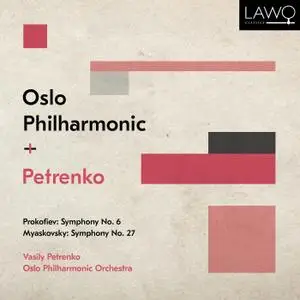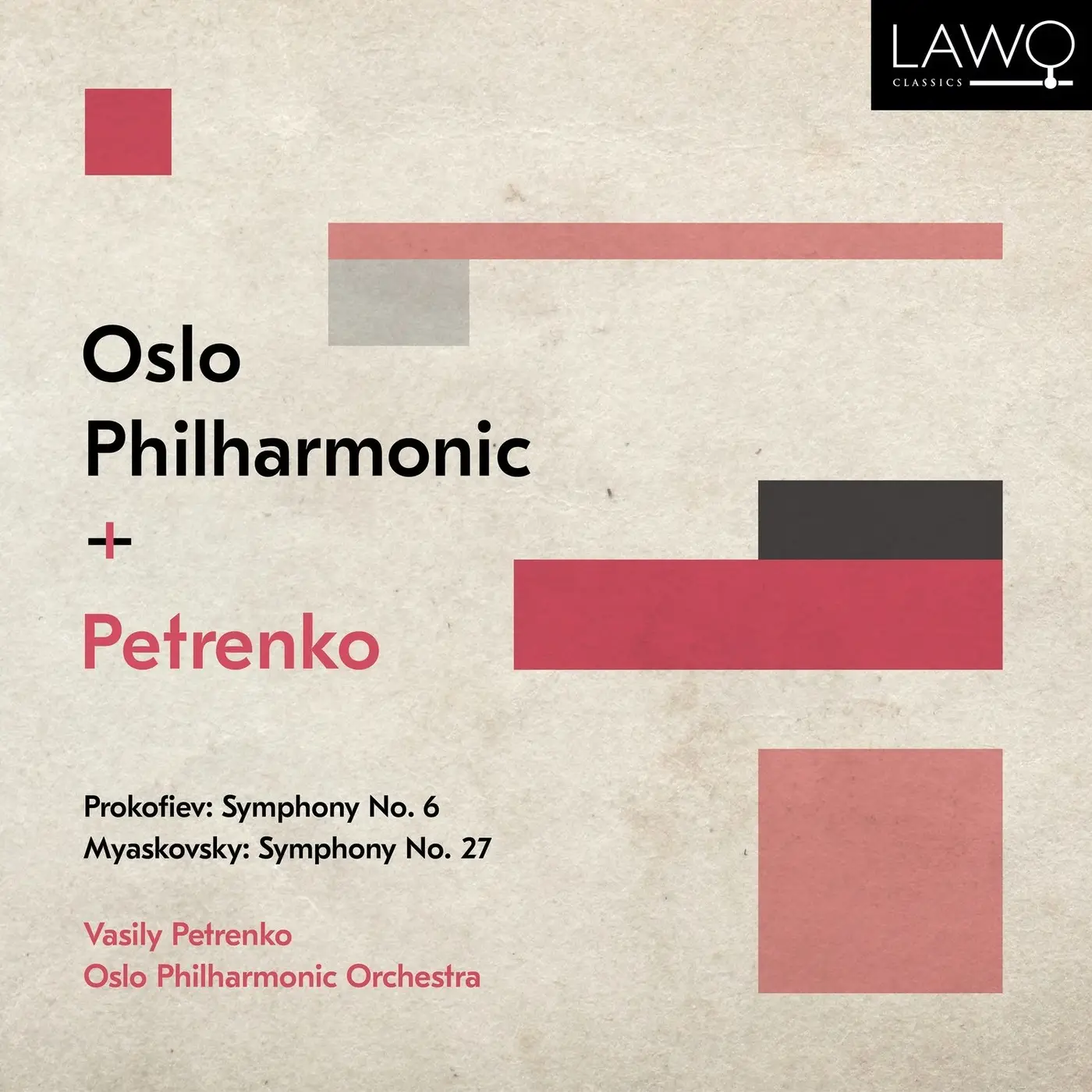Vasily Petrenko & Oslo Philharmonic Orchestra - Prokofiev: Symphony No. 6 - Myaskovsky: Symphony No. 27 (2021)
WEB FLAC (tracks) - 290 Mb | MP3 CBR 320 kbps - 175 Mb | 01:16:25
Classical | Label: LAWO Classics
WEB FLAC (tracks) - 290 Mb | MP3 CBR 320 kbps - 175 Mb | 01:16:25
Classical | Label: LAWO Classics
Sergei Prokofiev (1891–1953) composed his Symphony No 6 in E flat minor, Opus 111 between 1945 and February 1947, though his sketches date from 1944 - before his completion of the Fifth Symphony. The scoring is for large orchestra including piccolo, cor anglais, E flat clarinet, contrabassoon, harp, piano, celesta and an array of percussion. Although the key of E flat minor is extremely rare in the symphonic literature, Myaskovsky also wrote a sixth symphony in that key.Tracklist:
Disappointed with the reception of his music in the West, Prokofiev hoped for a great welcome on his return to Russia. As Francis Maes has written in A History of Russian Music, “While Serge Prokofiev’s talent is beyond question, his career as a composer was a succession of misjudgements …. All his actions from 1918 to 1932 can be seen as a step-by-step return, first to Western Europe, and then to Moscow …” By the latter part of the thirties many leading composers were in America, while Prokofiev was locked away in Russia. By the time of his Sixth Symphony he had generally adapted to the state’s demand for upbeat, optimistic music, yet this is a deep and personal work with an unmistakeably tragic element. Biographer Israel Nestyev wrote: “It seems as though the two Prokofievs, the old [often spiky and subversive] and the new, were engaged in a struggle [between] powerful, genuine lyricism and sudden outbursts of unrestrained expressionism …” Initially well received (Evgeny Mravinsky and the Leningrad Philharmonic gave the premiere in October 1947), the work was officially condemned the following year and was omitted from the repertoire of Soviet orchestras for many years.
Prokofiev’s own comments on the work were typically (and unhelpfully) terse: “The first movement is agitated, at times lyrical, at times austere; the second movement, Largo, is brighter and more tuneful; the finale, rapid and in a major key, is close in character to that of my Fifth Symphony, save for reminiscences of the austere passages in the first movement.” He also acknowledged that the symphony was partly inspired by the war years. “Now we are rejoicing in our great victory, but each of us has wounds which cannot be healed”.
Nikolai Myaskovsky (1881–1950) completed the last of his symphonies – in C minor, Opus 85 – in November 1949. His twenty-seven works in this genre are so remarkably diverse in character that it is almost impossible to define the “typical” Myaskovsky symphony. No 27 is often described as one of his most popular, but actually we would be very fortunate to find any of his symphonies, or any other compositions, programmed in a concert-hall outside Russia. Were it not for CDs and a very rare broadcast, we should never hear a note of his music. However, in the late 1930’s his music was more frequently performed in America, the Chicago Symphony’s conductor Frederick Stock being a notable advocate. Other major American-based conductors who “fought over rights to his scores” (Richard Taruskin) included Stokowski, Koussevitsky and Artur Rodzinski. Shostakovich regarded him as “the major symphonist after Mahler”, while Prokofiev wrote that Myaskovsky “was something of a philosopher – his music is wise, passionate, gloomy and self-absorbed”.
1. Symphony No. 6, Op. 111: I. Allegro moderato (14:28)
2. Symphony No. 6, Op. 111: II. Largo (15:00)
3. Symphony No. 6, Op. 111: III. Vivace (11:19)
4. Symphony No. 27, Op. 85: I. Adagio. Allegro animato (13:12)
5. Symphony No. 27, Op. 85: II. Adagio – Molto elevato – Più tranquillo – Tempo I Elevato – Più appassionato – Addolorato – Tempo I (14:14)
6. Symphony No. 27, Op. 85: III. Presto ma non troppo (08:11)
–––––––––––-
DON'T MODIFY THIS FILE
–––––––––––-
PERFORMER: auCDtect Task Manager, ver. 1.6.0 RC1 build 1.6.0.1
Copyright © 2008-2010 y-soft. All rights reserved
ANALYZER: auCDtect: CD records authenticity detector, version 0.8.2
Copyright © 2004 Oleg Berngardt. All rights reserved.
Copyright © 2004 Alexander Djourik. All rights reserved.
FILE: 06 Symphony No. 27 Op. 85 III. Presto ma non troppo.flac
Size: 36288320 Hash: 1313E0949B236731237FB355B31CB691 Accuracy: -m8
Conclusion: CDDA 100%
Signature: 6F45098813E15CCA2405C67F0C551A82A173361D
FILE: 05 Symphony No. 27 Op. 85 II. Adagio – Molto elevato – Più tranquillo – Tempo I Elevato – Più appassionato – Addolorato – Tempo I.flac
Size: 48952258 Hash: 65706ED06466F0CE8198281AFCB0484C Accuracy: -m8
Conclusion: CDDA 100%
Signature: 1BB4E2DD655BFAA623354D33BC5E72B3B4F7A7BA
FILE: 04 Symphony No. 27 Op. 85 I. Adagio. Allegro animato.flac
Size: 47746290 Hash: 0233895040AF2F05238D6C68943DA08C Accuracy: -m8
Conclusion: CDDA 100%
Signature: C454F9680AB897278EA5C3C2FE0242B4CB4B3969
FILE: 03 Symphony No. 6 Op. 111 III. Vivace.flac
Size: 48860016 Hash: 367C2E7E650908C9DE65870B49CE1DCD Accuracy: -m8
Conclusion: CDDA 100%
Signature: E22F7F54E9B926252EA4D0D11F6A60D1542F7636
FILE: 02 Symphony No. 6 Op. 111 II. Largo.flac
Size: 64396369 Hash: BD4C31E45023AF21EECCC039B55438B5 Accuracy: -m8
Conclusion: CDDA 99%
Signature: 700BF052F7E329784BE044CC0CDC47D51754EA1E
FILE: 01 Symphony No. 6 Op. 111 I. Allegro moderato.flac
Size: 57662751 Hash: DD1AF4C843F348F76EC11421F6267A8D Accuracy: -m8
Conclusion: CDDA 100%
Signature: 912BC4D52A74ADA66098F2050801D7439551EF22
DON'T MODIFY THIS FILE
–––––––––––-
PERFORMER: auCDtect Task Manager, ver. 1.6.0 RC1 build 1.6.0.1
Copyright © 2008-2010 y-soft. All rights reserved
ANALYZER: auCDtect: CD records authenticity detector, version 0.8.2
Copyright © 2004 Oleg Berngardt. All rights reserved.
Copyright © 2004 Alexander Djourik. All rights reserved.
FILE: 06 Symphony No. 27 Op. 85 III. Presto ma non troppo.flac
Size: 36288320 Hash: 1313E0949B236731237FB355B31CB691 Accuracy: -m8
Conclusion: CDDA 100%
Signature: 6F45098813E15CCA2405C67F0C551A82A173361D
FILE: 05 Symphony No. 27 Op. 85 II. Adagio – Molto elevato – Più tranquillo – Tempo I Elevato – Più appassionato – Addolorato – Tempo I.flac
Size: 48952258 Hash: 65706ED06466F0CE8198281AFCB0484C Accuracy: -m8
Conclusion: CDDA 100%
Signature: 1BB4E2DD655BFAA623354D33BC5E72B3B4F7A7BA
FILE: 04 Symphony No. 27 Op. 85 I. Adagio. Allegro animato.flac
Size: 47746290 Hash: 0233895040AF2F05238D6C68943DA08C Accuracy: -m8
Conclusion: CDDA 100%
Signature: C454F9680AB897278EA5C3C2FE0242B4CB4B3969
FILE: 03 Symphony No. 6 Op. 111 III. Vivace.flac
Size: 48860016 Hash: 367C2E7E650908C9DE65870B49CE1DCD Accuracy: -m8
Conclusion: CDDA 100%
Signature: E22F7F54E9B926252EA4D0D11F6A60D1542F7636
FILE: 02 Symphony No. 6 Op. 111 II. Largo.flac
Size: 64396369 Hash: BD4C31E45023AF21EECCC039B55438B5 Accuracy: -m8
Conclusion: CDDA 99%
Signature: 700BF052F7E329784BE044CC0CDC47D51754EA1E
FILE: 01 Symphony No. 6 Op. 111 I. Allegro moderato.flac
Size: 57662751 Hash: DD1AF4C843F348F76EC11421F6267A8D Accuracy: -m8
Conclusion: CDDA 100%
Signature: 912BC4D52A74ADA66098F2050801D7439551EF22



